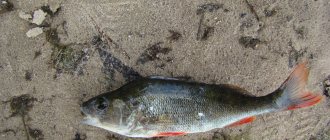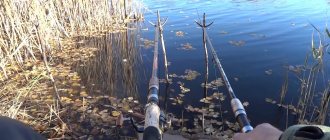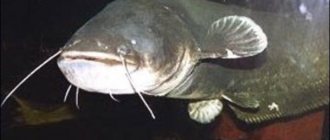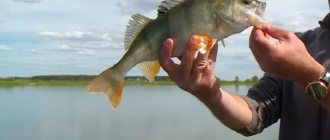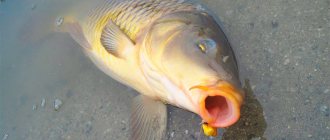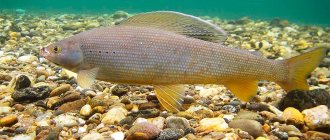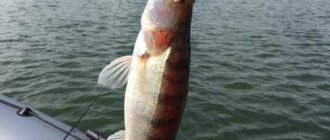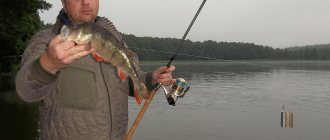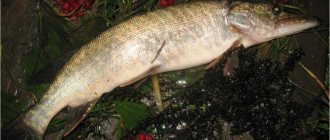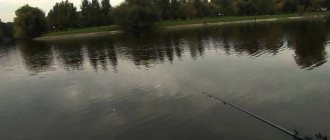Is it possible to catch pike with ultralight?
Despite the fact that it will most likely be difficult to catch a really large pike weighing 5 kilograms or more, specimens weighing 2 kilograms or so may well become a frequent catch.
All professionals unanimously report that fishing a one-kilogram pike on a 0.14 mm fishing line is no less exciting than a five-kilogram fish on a 0.2 mm fishing line. But with proper skill, you can catch large pike with light tackle.
Ultralight Club
Shishlyannikov A.
Ultralight in the fall is not only about enjoying nature and a pleasant trip with a light spinning rod, but also an exciting fishing process, which has some distinctive features. For example, not only you have the opportunity to see the fish, but it also sees, and more often, hears you... What does it take to experience all the delights of ultralight fishing in the fall? It would seem not much: a portion of initiative, a day free from work or study, and the shore of a reservoir, the choice of which will be based on the personal preferences of the fisherman. Small rivers of the Volgograd region: Liska, Chir, Sakarka, Sukhaya Mechetka, as well as eriki and lakes of the Volga-Akhtuba floodplain are an excellent testing ground for twitching in general, and in particular for autumn twitching. But often a person who has the “right” gear and subtle, outstanding technique can be left without a single bite. Personally, I made a lot of mistakes on the way to understanding the art of twitching. But now I can share my experience.
Equipment and gear. Seasonal features.
One of the distinctive features of ultralight fishing is constant movement along the coastline with minor stops, so special attention should be paid to the lightness and comfort of clothing and equipment. The time of year dictates its own rules: sudden changes in weather, rain, and wind require waterproofing and windproofness. There may be water and mud obstacles along the way, and wading boots will be the solution. It seems that everything is natural... But the slightest miscalculation, and fishing from an aesthetic pastime will turn into a mockery of one’s own body.
I, like many fishermen, had to start from scratch. Fishing in old boots and jeans turned into horror. Wet feet and a chronically cold lower back drove me to the counters of sportswear stores, where I could find: a set of thermal underwear, ski overalls and a jacket. The question of the quality of thermal underwear rather depends on the material wealth of the fisherman and his worldview. Some people just don’t like the feeling of wearing a cheap thing, some don’t care, some don’t care, but they can’t afford an expensive one. I can assure you that, having changed several sets, I did not feel a direct relationship between the quality of the thermal suit and the increasing price tag. But it’s better not to skimp on a jacket and overalls. It is almost impossible to get inexpensive, waterproof, windproof clothing that wicks moisture away from the body.
As for gear, in my opinion, in the fall it’s worth relying on versatility. During this period, the likelihood of a large fish grabbing a hold of a large fish, for example, a pike or a vagrant asp, is greater than ever. In autumn, it is also increasingly necessary to look for fish in the deepest places, so it is desirable that the stick could also serve for fishing with microjigs, that is, it should be loud enough and rigid enough.
In general, choosing an ultralight set to suit your conditions is a very difficult topic. I think I will write about this in more detail separately.
Choosing a location. Lake surprises
Having arrived directly at the reservoir, we will take into account the main feature of autumn - the lack of time - and begin to determine the most promising fishing spot. Most often, I was able to find fish near half-submerged bushes, snags, tufts of settled, drooping aquatic vegetation located a short distance from the general mass, the border of grass and the “clean” bottom. But, fortunately for the modern fisherman, not everything is so banal. An interesting example is the Latoshinsky quarry (northern part of Volgograd, behind the hydroelectric power station village). The scene of action is a huge, by the standards of steppe lakes, water area with thick snags and sandy beaches, holes up to 10 meters and shallow backwaters. Beach, clean sand, depth 20 centimeters, 7 meters away there is a dark strip of landfall (as it later turned out, up to 3 meters) - a classic perch place, but after the wobbler touches the bottom, a pike is pleased to come out. A quick change of bait, a slightly adjusted retrieve and... strike! The squeal of an unprepared clutch... But the hands do their job regardless of the consciousness, overwhelmed by emotions and adrenaline. And here it is, pike - rather the exception than the rule. The same beach also worked on other days specifically for toothy ones, when similar neighboring places shot exclusively for perch.
It is also worth noting the peculiarity of floodplain lakes, which are often connected to each other by eriks or dams. The exits of the latter into lakes almost always attract predators with a light current and an expanded food supply created by the migration of peaceful fish and all kinds of living creatures. In the area of the Kapyarskaya floodplain, I often caught such places. Erik Peschanka shot especially brightly in the area just above the ford. Perch and pike seemed to be lining up for the bait. That's just one episode.
...Another wiring of a subsurface wobbler. An arrow is separated from the coastal reeds. Impact!.. Disappearance... Instantly I place the bait along the same trajectory. Wiring. I've almost passed the first bite. Attack from below - candle! The pike flies off in one direction, the wobbler in the other. Trembling knees. It's a shame. The third attempt, which almost rarely ends successfully when using the same bait. Well, what if? And then something happens! The pike jumps out of the water and attacks the bait from the air! Splashes, noise, cord tension... Well, I finally got it! And at the very moment of delight and jubilation before the subsequent struggle... the fishing line sagged. I took a bite... Admiration for what I saw mixed with the bitterness of losing a working bait... It happens! Moreover, you cannot give preference to perch or pike when exploring the water area; they, as a rule, react to bait according to the “first-time, first-time” system. After all, we usually create an imitation of prey: a wounded fish, a frightened fry, or simply carelessly moving living creatures that have approached the predator at a minimum distance. Such objects are equally loved by both pike and perch.
The river is unpredictable
The main difference between a river and a lake is the presence of a current, a constant change in the topography (bed, coastline, the formation of new edges, holes), and, consequently, parking and hunting grounds for fish. A river is not a body of water that can be studied once and for all. Therefore, fishing becomes more and more interesting from year to year. Although there is also some system here.
First of all, I try to catch coastal snags, dams above and whirlpools below beaver dams (they can be found on small rivers of the Don basin: Sakarka, Liska, etc.), local holes, exits from them, places of sharp turns in the channel, whirlpools above and below fords Sometimes the mouths of rivers that flow into a larger body of water also bring good luck. But here there is a high probability of encountering poacher’s nets and losing your favorite wobbler. Also worthy of attention are coastal bushy plants with a half-washed root system, where I was able to find perch camps on floodplain eriks, and pike ambushes on small rivers. It would be a crime to pass by coastal reed thickets (popularly called reeds) or islands, but you still shouldn’t get hung up on them: 2-3 baits, 2-3 retrieves each, and if there are no exits or bites, run on, because there’s time Less and less!
But such places can be found on any of the small rivers. Cape, light current, wall of reeds, depth along the riverbed 2-2.5 meters. The place is ideal: behind the dense vegetation I am not noticeable to the fish, and it continues to actively feed, giving itself away with periodic pops. It is extremely convenient to deliver bait to the scene of action from a sandy cape. Accurate casting along the bank upstream - I shoot the first most impatient pike with a Pensil walker from Angler's. I wait about ten minutes for everything to calm down, change the bait to a Jackal Mask minnow seven centimeters long, absolutely without “my game”, 4-5 casts - I take two more pike. I wait ten to fifteen minutes and catch the most passive predators with a pot-bellied fat IMA Imatetra di or a Lucky Craft Deep Cra-Pea shad with a very active “own game” - plus one more pike. Then I see the point of staying in this place for about ten minutes with a smaller wolf (for example, Towadi) - and now there are four perch in the standings.
Fishing technique. Basic part
In autumn, ultralight is no less interesting than in summer: it is the same subtle, aesthetic and emotional fishing, shaded by the colors of the new season. The emotionality and aesthetics of this type of fishing lies in the ability to see the game of the wobbler you create, as well as the moments when the bait is released and attacked by a predator, because the water is clearer than in summer. In my opinion, these are the most exciting moments of fishing. My autumn twitching began with a school of river perch. I didn’t have to work hard to get a bite. But I wanted to catch on every retrieve, and not every third.
Then I had to deal with a “harmful” single autumn perch, which refused to respond to “perch jerking”, and to “long jerk” retrieves, and to many other variations. I watched. I distinguished two options for the state of the fish: the first - the perch is feeding, the second - is in the process of digesting the eaten fish, but is not averse to profiting from a gaping or shot fry. However, the technique of autumn twitching for both options is almost the same - it will be dominated by short, sharp shudders of the wobbler with long pauses, simulating a wounded fry without a definite trajectory of movement. Moreover, when catching perch, you should perform 2-3 very small and frequent jerks and give a pause of 2-4 seconds, during which the wobbler should completely stop and begin to perform movements depending on its buoyancy.
In the fall, suspenders (lures with neutral buoyancy) work best for me, but with the right approach, sinking models do not disappoint. The suspender will pause and imitate a confused live fish. Whereas a sinking wobbler will fall down, creating the illusion of a fry dying. And to determine which of the “prey” the fish you are catching likes is your task. It is at the end of the pause that the bite most often occurs. It may look like a confident blow or a sagging thread. Next, you will have to experiment and find the key to the “fish mood” through various combinations of changing pauses and jerks.
Another wiring option is possible, which I use for catching perch exclusively in the fall: playing with the slack of the cord is done in such a way that the wobbler in the water column performs the movements of the “walking” walker as slowly and evenly as possible (IMPORTANT: the bait should not have any “game of its own” "). The bite will be felt as a blow or a pull. The fundamental difference from twitching at other times of the year will be the maximum reduction in the intensity and speed of the retrieve, which is due to the passivity of the fish due to the low temperature. However, do not forget that there are exceptions to every rule!
Where to start with perch
In my hunt for a striped predator, wobblers performed well: Mask 75 from Jackallbros, Orbit 65MR-S SP from Zip Baits and SC Natia-ZG 55SP from Daiwa, perfectly complementing each other and covering the depth range from 0.3 to 2 meters. You can also use smaller “pinocchio” type MasuMasters 48F or 38F: the catch will directly depend on the preference of the fish and the angler’s ability to creatively present the bait. In the classic version, Mask 75 does not have “its own game” at all and works well in conditions of weak or no current. The Orbit 65MR holds a strong current well, trembles slightly with any movement of the rod, and works in tandem with the Mask75. Daivo's SC Natia-ZG 55SP is more versatile. With simple manipulations it is easy to achieve a lively “game” or the absence of any movements. You need to have this wobbler in your box in a trout color. Without it, the set will be incomplete. In late autumn, the wide range of movements of this wobbler brings it to the forefront in catching perch.
A few words about toothy
Late autumn is absolutely not the time when pike grab everything. It's cold, and she doesn't intend to make unnecessary movements. But it still “responds” to ultralight baits. In order to seduce a toothy predator on a date with us, we will start from the technique described above. In it we should increase the number of jerks and their amplitude to three or four, and the pause should be 4-6 seconds. And the pike will not let you get bored, especially if the fishing is done near snags, where forcing events with ultra-thin gear is inevitable. Perhaps the fish will come out for the bait - then, in order to provoke a bite, it is advisable to change the direction of the retrieve and slightly reduce the amplitude of the jerks of the wobbler. If the predator continues to ignore all your efforts, then you should quickly change the “pinocchio” to one radically different from the previous one and catch the interested pike. In some cases, this technique also helps when catching passive large perch.
Orbit 65MR-S SP wobblers from Zip Baits performed well; TinyFry 50SP from Jackallbros and a budget minnow CNK 75F from GROWS CULTURE, which you should have at least to determine the presence of poaching gear or its remains. Each of these wobblers complements the other, and in this configuration they are the minimum set, allowing even a novice fisherman to “go from scratch” when mastering the basic technique from the first fishing. However, among the huge number of ultralight wobblers provided to us by the Japanese industry and not only, everyone can choose their own combination of baits and the key to their individual “behavior”, on which “performance” will depend.
So why do you need to select wobblers, experiment with wiring, and assemble ultra-thin tackle? All in order to experience a hard blow, emotions, the extreme strength of the gear... and a feeling, an exceptional fishing feeling of happiness when catching a relatively small fish, or indeed any fish. And all this is not there, somewhere under water, but before our eyes, 5-10 meters away! Exit, attack from bottom to top with a candle! The wobbler and the pike fall a meter apart. Oh! Next move: exit, tangential side attack! Was it a mistake again? My knees begin to tremble, and my hands lose the precision of my movements... Having overcome the trembling and excitement, I manage to make another cast. What is this? Candle - attack from top to bottom! A sea of splashes! Eat! The friction clutch squealed, the ringing music of the line and rod can be heard, working to the maximum! A jerk, another jerk. It's hard to breathe. The fish is about to win. Trembling and uncertainty fade into oblivion. No, that was not the case, just another minute and the resistance was broken. Here she is, a two-kilogram beauty, standing parallel to the shore. A slight movement of the hand, and the prey on the shore nobly moves its fins. The jubilation of the “puppeteer” and his 5-centimeter subordinate, awarded, like orders, with new battle scars.
Minus is a problem
When the air temperature approaches zero and steadily begins to “walk” in the range from +3 to -1, a thin line of ice has already formed on the banks of small rivers, another feature of fishing in late autumn is revealed - freezing of the line and rings. This problem seriously affects the quality of twitching and the wear rate of the thread, which increases significantly. The strength of the cord also decreases. But there is no need to give up fishing because of this. In the modern fishing industry, there are already liquids that prevent the freezing process, such as KOSADAKA and others. And in the absence of special equipment, you can use ordinary vegetable oil. And then even a light frost is not a hindrance to you.
Fishing is great in this weather on the river. Liska, where it is at this time that pike become active and perch can be found. Or in the places where floodplain eriks flow into the Volga or Akhtuba, where large perch often gather in schools and begin hunting.
Catch for fun
Ultralight is not yet very widespread among Volgograd fishermen. Perhaps this is due to the presence of large rivers near the city - the Volga, Don, Akhtuba, and being spoiled by large fish. But, in my opinion, ultralight, as an alternative fishing method, should have its place and development. Considering the degree of employment of the average city resident, this style allows you to reduce the time spent on fishing while maintaining the aesthetic pleasure of such a pastime. It also provides enormous potential for expanding the range of actions. Ultra Light is creativity and manipulation at its most extreme! And the gold of coastal forests and fields, the transparency of the water, perhaps a light drizzle and the sun breaking through the clouds complement the palette of sensations obtained on the reservoir.
Features of catching pike with an ultra-light spinning rod
In fact, back in the 60s of the last century it was noted that large predators often prefer small bait. That’s when ultra-light spinning rods began to develop.
The main problem was casting a small bait without an additional sinker. At that time, this was not possible due to the nature of the gear, so the load was left approximately 1-1.5 m from the turntable, which complicated the casting process.
At the moment, this problem has been solved thanks to special baits.
The main feature of this type of fishing is to catch large pike with lightweight tackle. The process of fishing will naturally be a little drawn out, but for many it brings pleasure. It is very important not to try to drag the prey with a drill, as in this case the rod or equipment may not be able to withstand it. You need to harass the fish, gradually pulling it in, feeling the tension of the fishing line.
Where, when and how to catch
To catch pike, it is very important to consider the time of year. Based on this, you will have to change not only the fishing tactics and bait, but also choose the fishing location. During spring fishing, the following rules must be taken into account:
- using ultralight, you need to fish with the clutch released;
- the pike will be located in shallow water, where the water warms up better;
- it is tedious to bring the bait almost to the very feet;
- baits should be small;
- wiring should be as slow as possible.
In summer, it is necessary to catch this fish taking into account the following rules:
- in the first month of summer, you need to look for fish in places with a lot of vegetation in the water;
- baits must have a pronounced game;
- the higher the water temperature rises, the more often the fish will go to depth;
- To effectively fish over aquatic vegetation, you need to use surface baits.
About
Choosing an ultralight spinning rod
Ultralight spinning rods are the most sensitive equipment designed for catching predatory fish. Despite its small size and lightness, the rod is able to withstand heavy loads. Thanks to high sensitivity, the owner of a spinning rod can achieve impressive results. With its help, you can make very accurate casts over long distances, instantly make hooks and land large fish. When choosing a spinning rod, you need to pay attention to several characteristics.
Rod
The length of an ultralight spinning rod can vary from 1.6 to 2.4 m. In this case, it is necessary to take into account the characteristics of the reservoir. To catch fish in dense coastal thickets, it is recommended to choose models with a short rod.
Material
Lightweight spinning rods are made from the following types of materials:
- fiberglass;
- carbon fiber;
- composite mixtures.
In the production of budget models, fiberglass is used, which is sufficiently durable and does not require special care. For more expensive spinning rods, carbon fiber or carbon fiber is used. Unlike fiberglass, the material is able to quickly dampen vibrations that occur after casting the bait.
Test
Depending on the class, there are 3 types of ultralight spinning rods:
- Models labeled Extra Ultralight are considered the lightest. The upper limit of the test is no more than 2.5 g. Such spinning rods are designed for fishing at close and medium distances.
- The middle category can include baits that weigh up to 3.5 g. On models belonging to this class you can see the designation Super Ultralight.
- The greatest demand among buyers is for ultralight rods, which allow you to catch fish with baits up to 5 grams. Ultralight is ideal for beginners who find it difficult to use overly sensitive equipment.
About
It's a little easier with a reel
Smooth laying of the fishing line and an instant reverse stop are highly desirable. As for the sizes, I prefer the “thousanders”. But other fans of ultralight fishing successfully fish with both larger and smaller reels.
As for the fishing line, there are fishing sayings on this topic that are most applicable specifically to ultralight - “the fisherman breaks the fishing line, not the fish” and “if the fisherman doesn’t break it, he doesn’t catch fish . That is, you need to take your time when fishing, carefully adjust the clutch before fishing, although there will still be losses of bait, because very often predatory fish stay in “strong” places where hooks are common. But in any case, a relatively thin fishing line outperforms a thick one in many respects. This includes longer casting, successful catching of wary fish, and impeccable performance of capricious but catchy mini-lures. And aesthetics are not in last place, because ultralight is, first of all, an indescribable pleasure from working with thin tackle, which in the skillful hands of an experienced fisherman can work wonders.
Tricks for catching crucian carp and tench in summer
Unsuccessful feeder catch
Features of fishing with match gear
